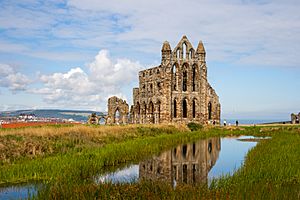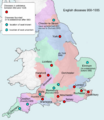Christianity in Anglo-Saxon England facts for kids
In the 600s, the Anglo-Saxons were mostly pagans, meaning they believed in many gods. But then, Christian missionaries came from Rome and started to teach them about Christianity. Some missionaries also came from Iona in Ireland, who followed a different style of Christianity called Celtic Christianity. They were very important in converting the people in Northumbria. However, after a big meeting called the Synod of Whitby in 664, the Anglo-Saxon church decided to follow the rules of the Pope in Rome.
Contents
How Christianity Came to Anglo-Saxon England
Christianity was already in Britain long before the Anglo-Saxons arrived. It came with traders and soldiers from the Roman Empire around the 200s. In 313, the Roman Emperor Constantine said Christians could practice their faith freely. Soon after, three bishops from Britain even went to a church meeting in France. This shows that Christianity was already organized in Britain.
Later, around 429, some British bishops asked for help with new ideas that were causing trouble. A leader named Germanus of Auxerre came to help. He even led the Britons to victory against invaders!
The Anglo-Saxons were a mix of people who came to Britain. They brought their old traditions and beliefs with them. Even so, some old Christian ways likely survived in Britain. The Anglo-Saxons settled in different areas, like Kent and Sussex.
Christianity Arrives in Kent
By the late 500s, Æthelberht of Kent was a powerful Anglo-Saxon king. He married a princess from France named Bertha. She was a Christian, and her marriage was allowed only if she could practice her religion. She brought her own priest, Liudhard, with her. An old Roman church was fixed up for Bertha near Canterbury. It was called Saint Martin's and was her private chapel.
Pope Gregory's Mission
In 595, Pope Gregory I in Rome sent a monk named Augustine to Kent. Augustine arrived in 597 on the Isle of Thanet and set up his base in Canterbury. King Æthelberht became a Christian before 601, and many others followed him. The king then helped build a monastery. After Augustine died, this monastery was named after him. It became a school for missionaries.
King Æthelberht's influence helped his nephew Sæberht of Essex and Rædwald of East Anglia also become Christian. However, Rædwald still kept an altar for his old gods. Pope Gregory sent more missionaries to help Augustine. He also advised them to use old pagan temples and traditions for Christian worship. This made it easier for people to switch to Christianity.
Christianity in the North
After the Romans left, the church in Britain became quite separate from the church in Europe. This different style is often called "Celtic Christianity." It focused more on monasteries than on bishops ruling large areas. It also had different ways of cutting hair for monks and different dates for Easter. The British clergy stayed active in the north and west of the country. They did not want to work with Augustine's missionaries.
Later, Edwin became king in Northumbria. He married Æthelburh of Kent, who was a Christian princess from Kent. She was allowed to keep her faith. A missionary named Paulinus of York came with her. Edwin eventually became a Christian, and so did many people in his court. But when Edwin was killed in battle in 633, Æthelburh and Paulinus returned to Kent. Northumbria went back to its old pagan ways.
Missionaries from Ireland
Christianity came to Ireland before the 400s. Irish monks, like Columba, later traveled to Scotland. In 563, Columba started a monastery on Iona island. This became a key place for spreading Christianity to the Picts in Scotland.
When King Æthelfrith of Northumbria died, his son Oswald had to live in exile. He spent time in Ireland and became a Christian there. When Oswald returned and became king of Northumbria, he asked the abbot of Iona to send missionaries. At first, a bishop named Cormán was sent, but he was too strict. So, Aidan was sent instead.
King Oswald gave Aidan the island of Lindisfarne, near his royal home. Since Oswald spoke both English and Irish, he often helped Aidan by translating for him. Aidan built churches, monasteries, and schools all over Northumbria. Lindisfarne became a very important center for Celtic Christianity.
Monasteries and Holy Places
Around 630, Eanswith, a princess from Kent, started one of the first monasteries for women in Anglo-Saxon England. Her aunt Æthelburh also founded a monastery. Many royal women became abbesses, leading these religious communities.
William of Malmesbury wrote that Sigeberht of East Anglia became a Christian while in exile in France. When he became king of the East Angles, he welcomed Felix of Burgundy from Canterbury. Felix set up a bishop's seat and a monastery. Sigeberht also welcomed Fursey and his brothers from Ireland. They built an abbey and helped convert many people.
Hilda of Whitby was a great-niece of King Edwin of Northumbria. After Edwin died, Hilda returned to Kent with Queen Æthelburh. Æthelburh started Lyminge Abbey, a monastery for both men and women. Hilda later returned north and became a nun. In 649, Aidan made her the abbess of Hartlepool Abbey.
Later, King Oswiu gave Hilda land to build a new monastery at Streoneshalh, which became known as Whitby. He also sent his young daughter, Ælfflæd, to be raised there. Whitby Abbey became a very important center for learning and a burial place for the royal family.
Solving Conflicts with Faith
In Anglo-Saxon times, if someone was murdered, their family would often seek revenge. This was called a blood feud. But Christianity offered another way: paying a "weregild." This was money paid to the victim's family to prevent more violence.
For example, in Kent, two young princes, Æthelred and Æthelberht, were murdered. To stop a blood feud, their sister, Domne Eafe, was given land to build a monastery at Minster-in-Thanet. This was a way to make peace and honor the murdered princes.
A similar thing happened in the North. King Oswiu of Bernicia had his cousin, King Oswine of Deira, killed. Oswine's closest relative was Oswiu's own wife, Eanflæd. To make up for the murder, Eanflæd demanded a large weregild. She used this money to build Gilling Abbey. The monastery prayed for both Oswiu's soul and Oswine's soul. By founding the monastery, Oswiu and Eanflæd avoided a family feud.
The Synod of Whitby (664)
By the 660s, there were two main Christian traditions in Anglo-Saxon England. In the north and west, people followed the Celtic ways from Iona. In the south, they followed the Roman ways brought by Augustine. This caused problems, especially with the date of Easter. King Oswiu followed the Celtic tradition, but his wife, Queen Eanflæd, followed the Roman one. This meant parts of the royal court celebrated Easter at different times!
In 664, King Oswiu called a big meeting at Hilda's monastery in Whitby to solve this problem. The Celtic side was led by Abbess Hilda and Bishop Colmán of Lindisfarne. The Roman side was led by Wilfrid, a churchman who had studied in Rome.
The meeting was a bit tricky because people spoke different languages, like Old Irish, Old English, and Latin. A bishop named Cedd helped by translating for everyone. Both sides argued their points. Colmán said they followed the traditions of St. John, while Wilfrid said they followed St. Peter.
In the end, King Oswiu decided to follow the Roman way. He said he didn't dare go against the one who held the keys to heaven (referring to St. Peter, whom the Pope was seen as a successor of). After this, Colmán resigned and went back to Ireland. This meeting was very important because it meant the Anglo-Saxon church would be united under the Pope in Rome.
Anglo-Saxon Saints
Many Anglo-Saxon kings and queens were later seen as saints. King Æthelberht of Kent and Queen Bertha of Kent were honored for bringing Christianity to the Anglo-Saxons. Their granddaughter Eanswith founded the first monastery for women in 630. Many royals chose to leave court life and become monks or nuns.
Sometimes, if a royal person was killed for political reasons, their death was seen as a martyrdom, making them a saint. The murdered princes Æthelred and Æthelberht were later remembered as saints. Oswine of Deira, who was betrayed and killed by his cousin, was also seen as a saint. Even the sons of Arwald of the Isle of Wight, who were killed after being baptized, were considered saints.
Having a saint in the family gave a royal family more respect and power. It could help them claim their right to rule an area, especially if they had just conquered it.
Anglo-Saxon Missionaries in Europe
Anglo-Saxon monks also became missionaries to other parts of Europe. In 644, a young monk named Ecgberht of Ripon became very ill. He promised that if he got better, he would travel and live a life of prayer. He later helped organize missions to the Frisians (people in what is now the Netherlands).
Around 677, Wilfrid, the bishop of York, was kicked out of his church by the king. He traveled to Rome and stopped in Utrecht, where he stayed with the Frisian ruler, Aldgisl. While there, Wilfrid helped spread Christianity.
The first missionary to Frisia was Wihtberht, but he wasn't very successful. Then, around 690, Ecgberht sent Willibrord and eleven friends to Christianize the Frisians. In 695, Willibrord became the Bishop of Utrecht. He also founded the Abbey of Echternach.
Later, in 716, Boniface joined Willibrord. Their work was difficult because of wars. Boniface then went to Rome and was sent as a missionary bishop to Germania (modern-day Germany).
Church Organization
In 669, Theodore of Tarsus became the Archbishop of Canterbury. In 672, he held a meeting called the Council of Hertford. Bishops from all over the Anglo-Saxon kingdoms attended. This meeting was a big step in organizing the Anglo-Saxon Church. They made rules about how the church should be structured.
After the council, Theodore traveled across Anglo-Saxon lands. He appointed new bishops and divided the very large church areas, called dioceses. Many of these dioceses were as big as the kingdoms themselves. This helped to create a more organized church system.
Images for kids
See also







